Since the launch of the commercial offer of 5th generation mobile networks and the installation of the first base stations in Portugal at the end of 2021, ANACOM has been reporting quarterly on progress in the deployment of these state-of-the-art mobile communications networks.
At the end of 2023, according to information reported by operators, there were 8,927 base stations in Portugal with 5G technology. This represents a 53% increase in the number of stations compared to the situation reported at the end of 2022.
Specifically, between the end of the 3rd quarter of 2023 and the 4th quarter of 2023, the network expanded as follows:
- The number of installed 5G base stations1 increased by 9%, with 701 new stations installed during the year.
- The number of parishes with a 5G station increased by 11%, including:
- 200 new Low-Density parishes with 5G stations (21% increase),
- 7 new parishes in the Autonomous Regions with 5G stations (5% increase).
NOS remains the operator that has installed the most 5G base stations, followed by Vodafone and MEO.
In terms of the number of stations installed per operator, compared to the previous quarter, NOS reported an increase of 9% (+ 346 stations), Vodafone 10% (+ 283 stations) and MEO 5% (+ 72 stations).
At the end of 4th quarter 2023, 5G base stations were distributed across 308 municipalities (every municipality in Portugal) and 2,136 parishes (69% of parishes in Portugal).
Taking the end of 4th quarter 2023 as a reference, NOS is the operator that installed the largest number of new 5G base stations, totalling 4,235 stations (47%), followed by Vodafone with 3,233 stations (36%) and MEO with 1,459 stations (16%).
Figure 1: Geographic distribution of 5G stations
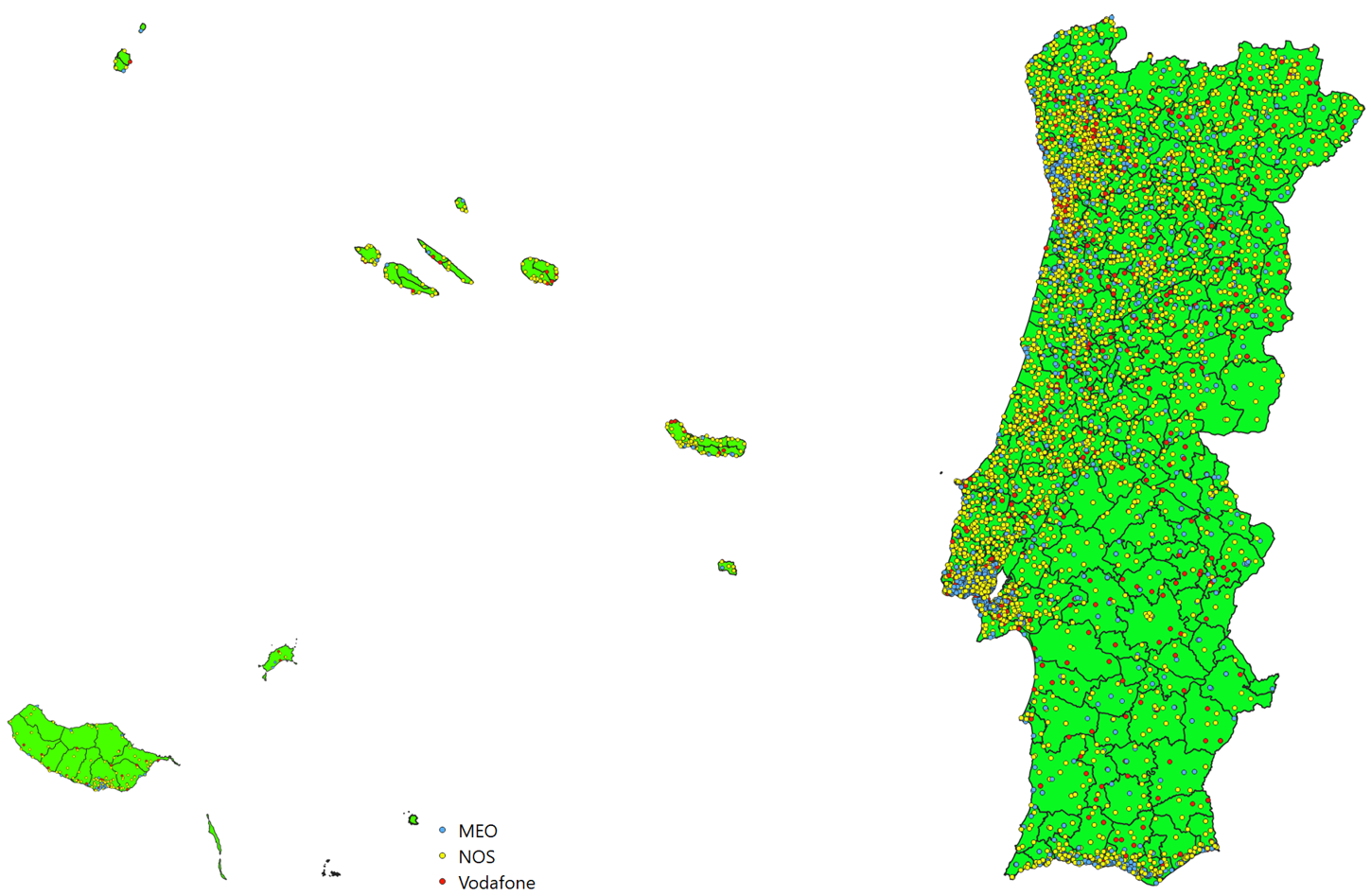
Note: the different images are not at the same scale. Overlapping points of the same size may misrepresent the number of stations per operator in relation to each other, especially in areas where the concentration of stations is highest.
The density of 5G base stations in Portugal, at the end of 4th quarter 2023, is approximately one base station per 10 km2. Also in average terms, there were 85 5G base stations per 100,000 inhabitants.
While these indicators demonstrate the growth of 5G networks in Portugal, their distribution throughout the territory is not homogeneous. A greater concentration of stations is evident along the western coastal strip, mainly between Viana do Castelo and Setúbal, and along the southern coastal strip (Algarve).
In general terms, the areas of the country with a higher density of stations also correspond to those areas where population density is higher or where there is a seasonal increase in the number of inhabitants.
MEO is the operator with 5G base stations in the largest number of municipalities (305 municipalities), followed by NOS with a presence in 303 municipalities and Vodafone in 301 municipalities.
Figure 2: number of municipalities in which each operator is present
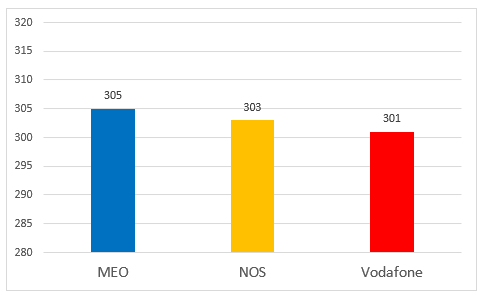
Of the 308 municipalities in Portugal with 5G stations, 296 have base stations installed by all three operators (MEO, NOS and Vodafone). In relation to the previous quarter, the number of municipalities where all three mobile operators are present with their own networks has increased by 20. Meanwhile, 9 municipalities have base stations installed by two operators and 3 municipalities only have base stations installed by a single operator (compared to 13 in the previous quarter).
The territorial distribution of base stations by operators is shown in the map in the following figure, indicating municipalities with three, two or one operator:
Figure 3: municipalities with 5G stations – territorial distribution of base stations by operators
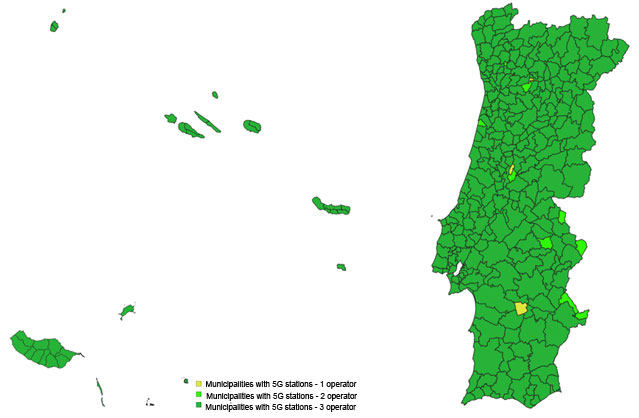
The 8,927 5G base stations installed across the country are located across 2,136 parishes, representing 69% of all parishes in Portugal.
Figure 4: parishes with 5G stations marked in green
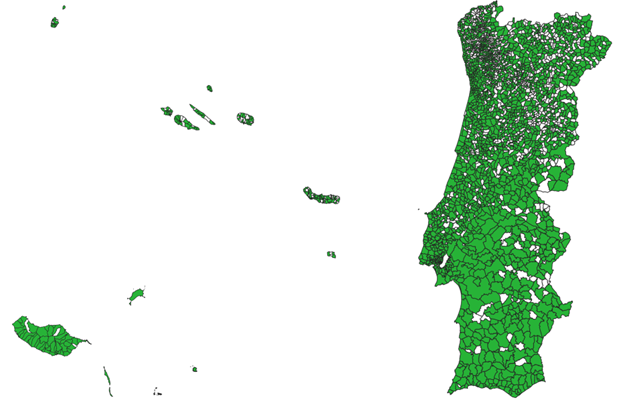
The total land area of parishes that have no 5G stations installed represents 17% of the national territory and, according to the 2021 Census, corresponds to around 9% of the national population2.
Based on the hierarchical system of territory division into NUTS III regions, the number of 5G base station installed in the administrative units of Douro, Beiras e Serra da Estrela, Beira Baixa, Médio Tejo, Alto Alentejo, Alentejo Central, Alentejo Litoral and Baixo Alentejo continues to be significantly lower than in the rest of the country.
From analysis of the data, it appears that a significant majority of 5G stations (57% of the total, corresponding to 5,081 stations) are located in “Predominantly Urban Areas”. Around 16% (1,385 stations) are installed in “Medium Urban Areas” and 28% (2,461 stations) in “Predominantly Rural Areas”, with an increase reported in the number of stations installed in these last two area types since the end of 3rd quarter 2023.
Figure 5: number of 5G stations by type of urban and rural area
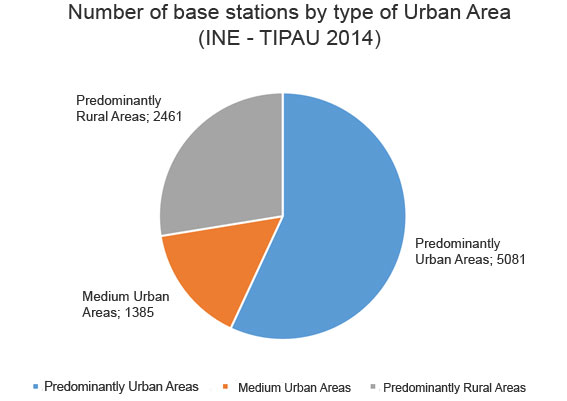
It can also be seen that the majority of 5G stations are installed in parishes that are not Low Density (5,357 stations, 60% of stations), while around 77% of parishes that are not Low Density already have at least one 5G station. Only 34% of total stations (3,030 stations) are installed in Low Density parishes.
Among Low Density parishes (1,813 parishes in total), 63% have 5G stations (1,149 parishes), while 664 parishes (37% of the total) do not have a 5G station.
In the Autonomous Regions of the Azores and Madeira, 77% of parishes have 5G stations (161 parishes), while 49 parishes in these regions remain without any 5G station installed.
Figure 6: distribution of 5G stations by parish type
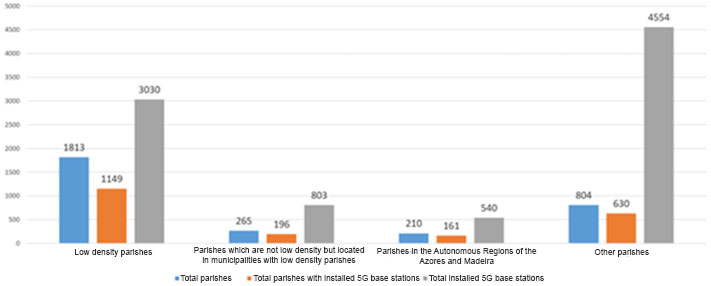
Comparing the number of installed stations with the number of parishes that have base stations installed, the following can be concluded:
Table 2: average number of stations per parish with a 5G station installed

Looking at the use of the different frequency bands allocated to operators, there is a clear preference for the 700 MHz and 3.6 GHz bands to provide services based on 5G technology.
The 700 MHz frequency band, which allows greater coverage, is used by the largest number of installed stations. However, while the 3.6 GHz frequency band offers more limited coverage, it tends to allow provision of services at higher download speeds than the 700 MHz band.
Noting that 5G stations can use more than one frequency band, the distribution of 5G stations per frequency band is as follows:
Figure 7: 5G stations by frequency band
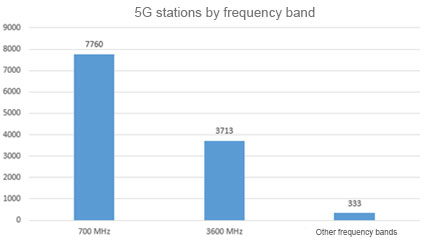
Considering the total number of stations (2G, 3G, 4G and 5G), and counting stations that include different technologies separately, it is seen that NOS is the operator with the largest number of stations, with a total of 1,8917 stations (36%). Vodafone has a total of 18,605 stations (35%), and MEO has a total of 15,102 installed stations (29%).
Figure 8: number of 2G, 3G, 4G and 5G stations per operator
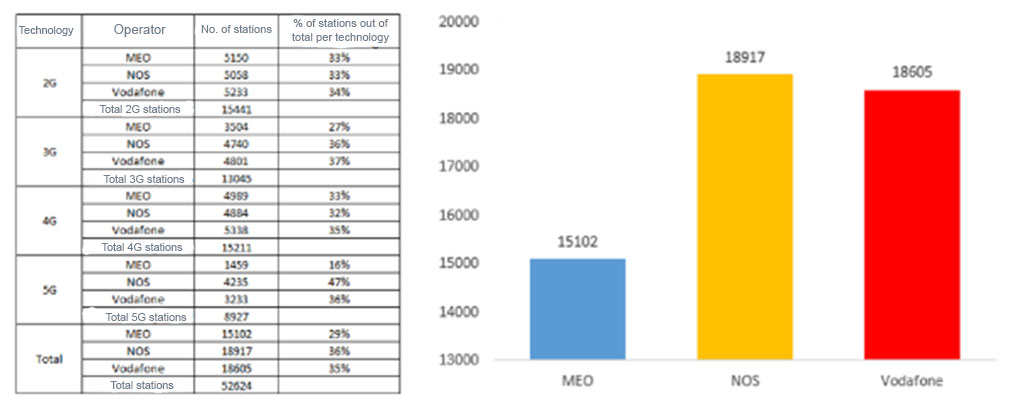
Figure 9: number of 2G, 3G, 4G and 5G stations per operator
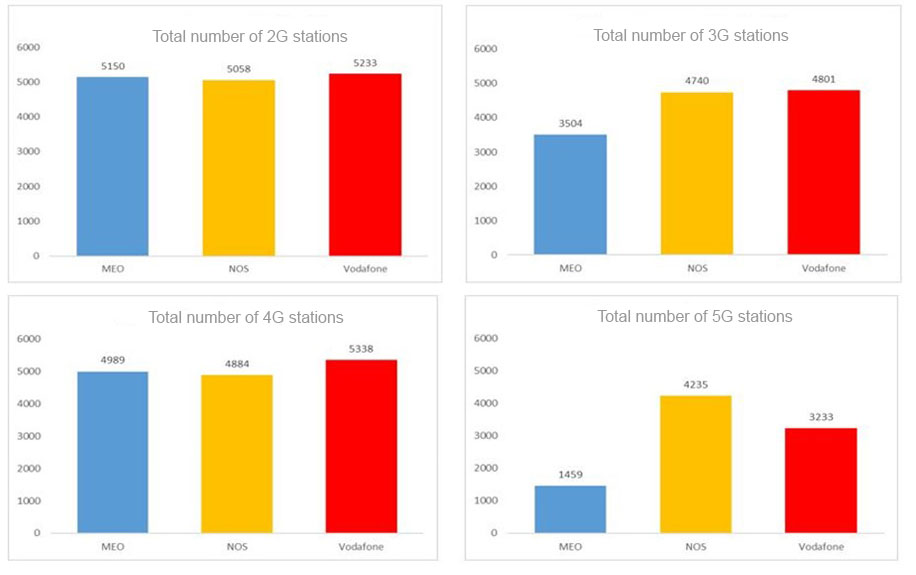
It should be noted that many of the 2G, 3G, 4G and 5G stations installed by operators are installed in the same location, so it is important to analyse the total number of locations in which each operator has stations installed. As such, it can be seen that Vodafone has stations in 5,584 locations, MEO in 5,209 locations and NOS in 5,196 locations.
Figure 10: total locations with 2G, 3G, 4G and 5G stations, by operator
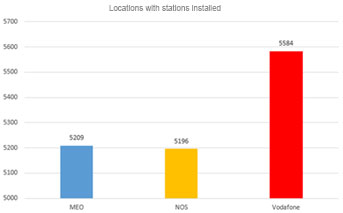
In conclusion, since the rights of use of radio spectrum were issued at the end of 2021, following the 5G Auction, it can be seen that operators have been making investments in their respective mobile networks. To this end, by the end of 2023, MEO, NOS and VODAFONE have installed 8,927 base stations associated with 5G.
These base stations are distributed throughout the country and are present in all municipalities in Mainland Portugal and in the Autonomous Regions of Madeira and the Azores (in most municipalities all 3 operators are present). Base stations are also present in 69% of the country's parishes.
Given the characteristics of 5G mobile networks - which are expected to have a relatively high degree of antenna density versus previous technologies - it is expected that the rate of investment in the installation of additional base stations will continue to be high, as operators continue to strengthen network coverage and increase capacity.
1 A 5G base station is characterised as a radiocommunications station with at least one transmitter using 5G mobile technology, located in a specific geographic location.
2 As ANACOM has explained, a parish may not have any station installed within its boundaries, but its territory may still receive coverage from base stations installed in an adjacent parish. The fact that 10% of the national population resides in parishes where there are no 5G stations cannot be interpreted as meaning that 90% of the national population has coverage. Likewise, the existence of one or more 5G stations in a parish does not mean that 100% of the population of that parish has coverage.




